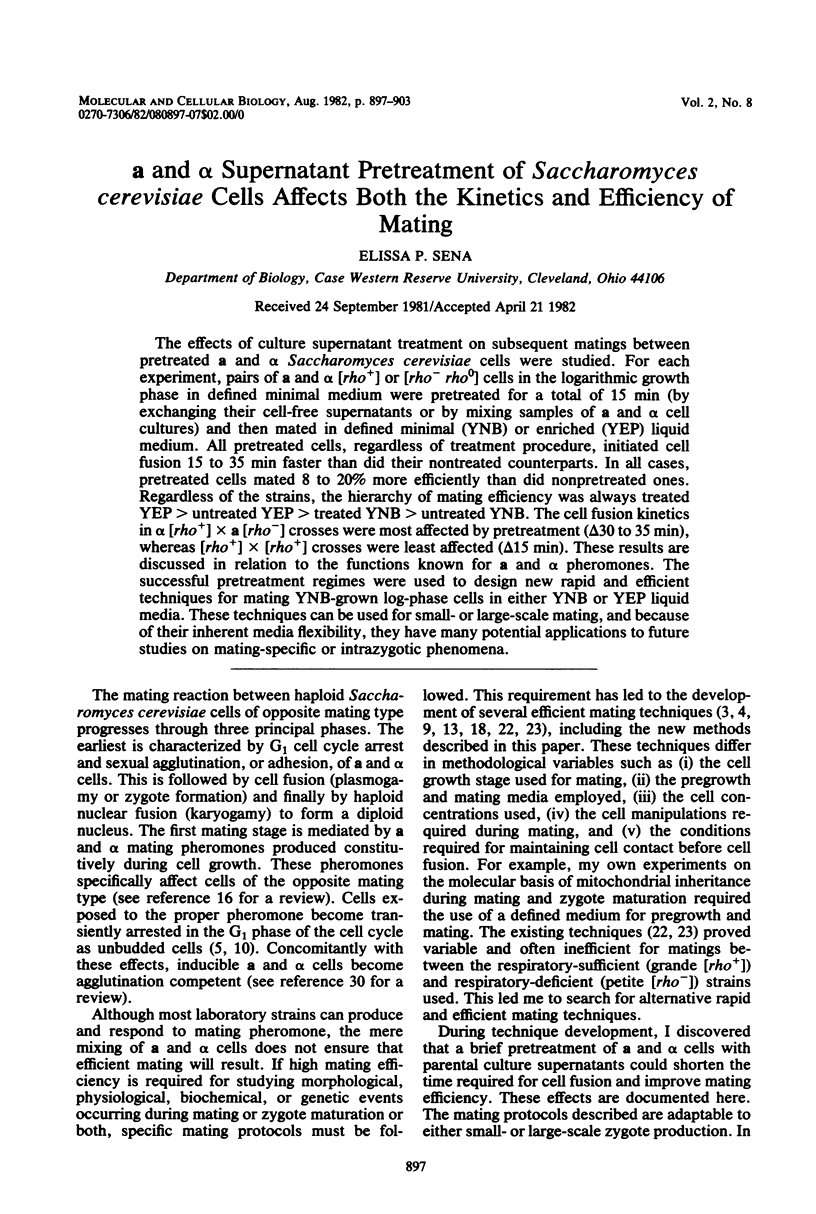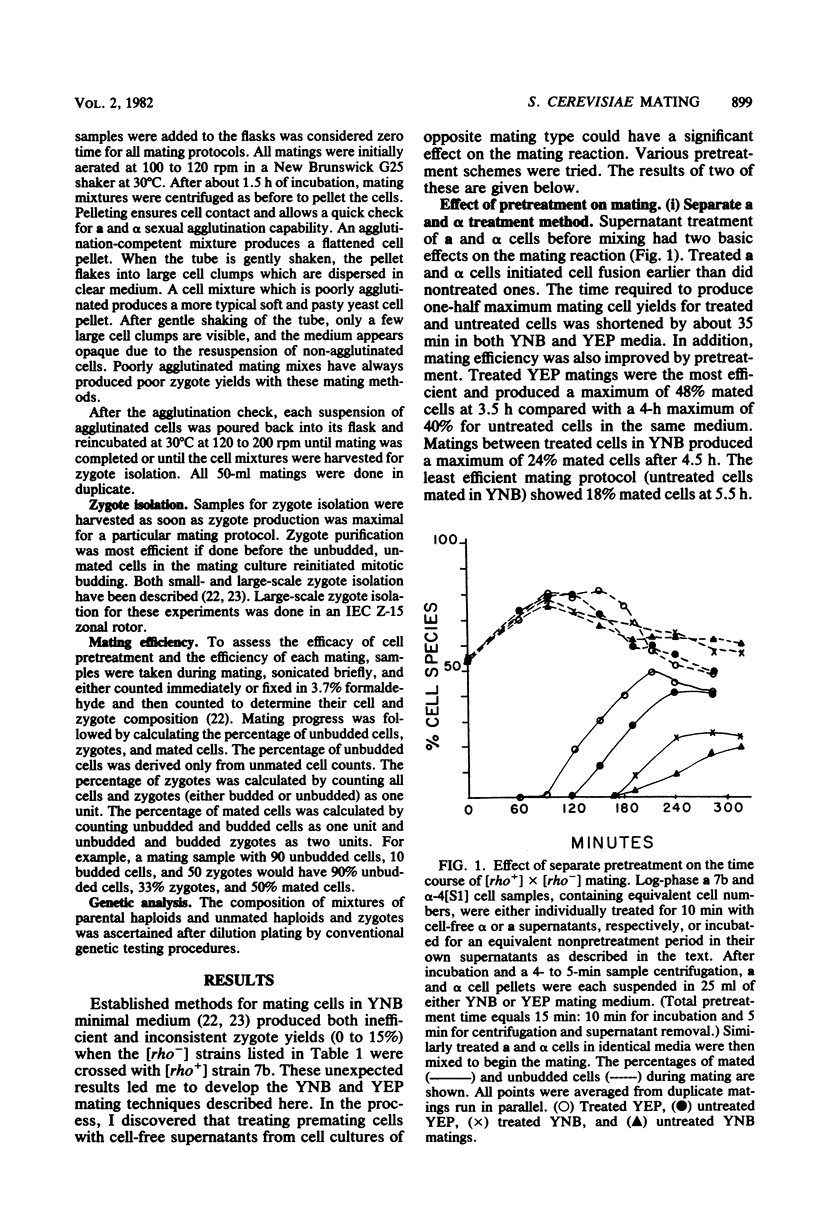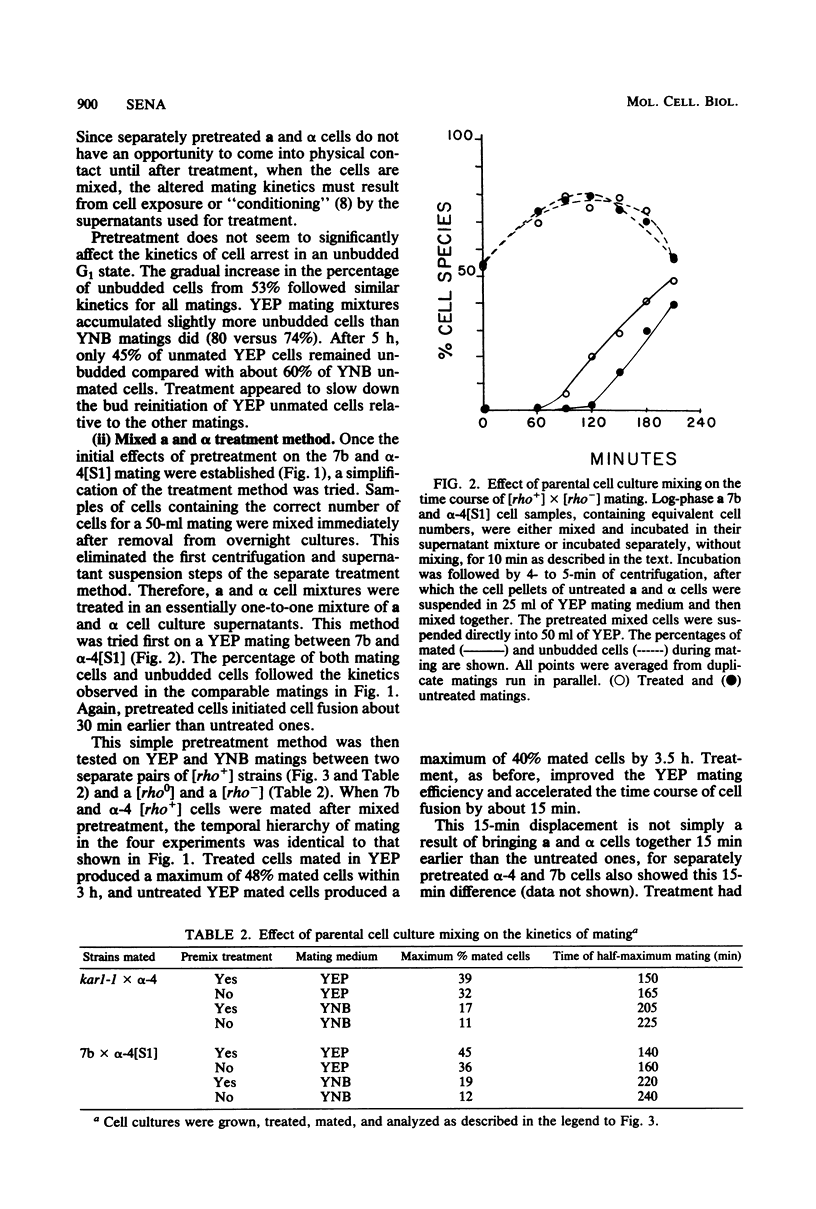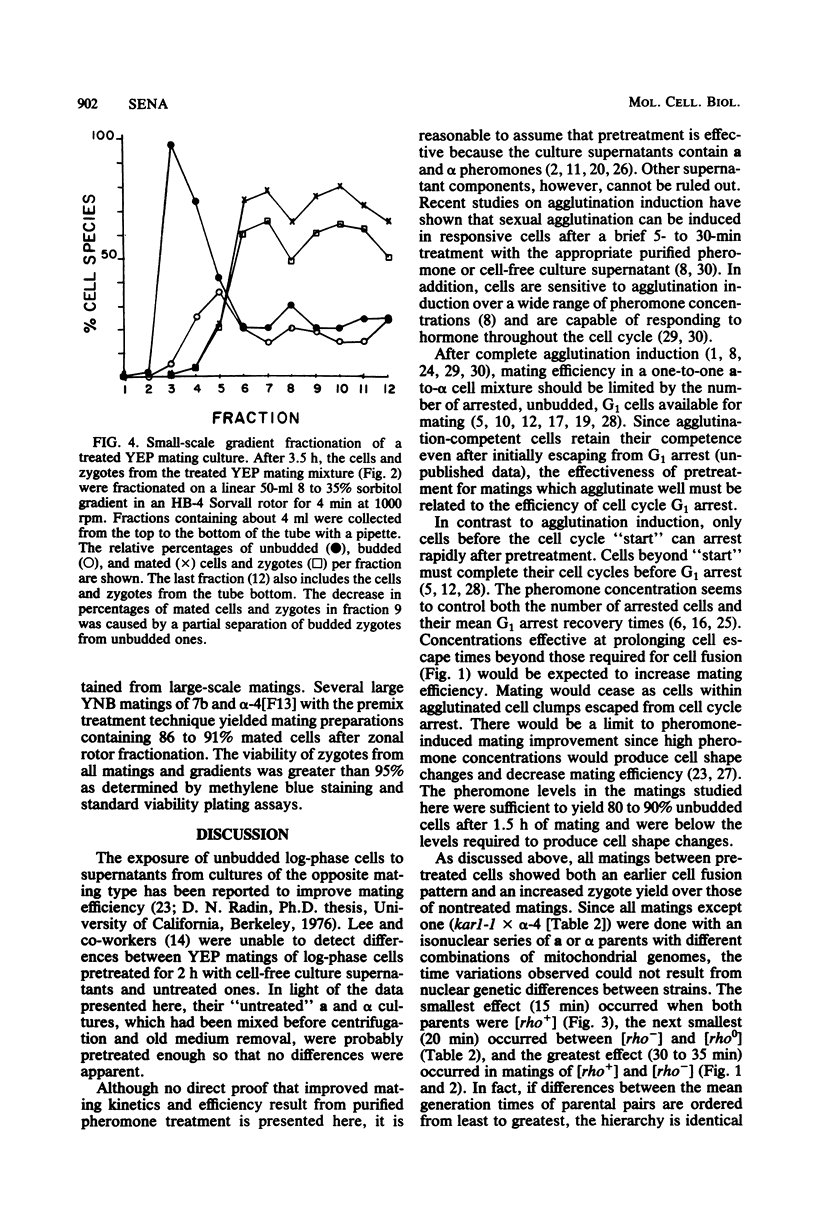Abstract
The effects of culture supernatant treatment on subsequent matings between pretreated a and alpha Saccharomyces cerevisiae cells were studied. For each experiment, pairs of a and alpha [rho+] or [rho- rho0] cells in the logarithmic growth phase in defined minimal medium were pretreated for a total of 15 min (by exchanging their cell-free supernatants or by mixing samples of a and alpha cell cultures) and then mated in defined minimal (YNB) or enriched (YEP) liquid medium. All pretreated cells, regardless of treatment procedure, initiated cell fusion 15 to 35 min faster than did their nontreated counterparts. In all cases, pretreated cells mated 8 to 20% more efficiently than did nonpretreated ones. Regardless of the strains, the hierarchy of mating efficiency was always treated YEP greater than untreated YEP greater than treated YNB greater than untreated YNB. The cell fusion kinetics in alpha [rho+] X a [rho-] crosses were most affected by pretreatment (delta 30 to 35 min), whereas [rho+] X [rho+] crosses were least affected (delta 15 min). These results are discussed in relation to the functions known for a and alpha pheromones. The successful pretreatment regimes were used to design new rapid and efficient techniques for mating YNB-grown log-phase cells in either YNB or YEP liquid media. These techniques can be used for small- or large-scale mating, and because of their inherent media flexibility, they have many potential applications to future studies on mating-specific or intrazygotic phenomena.
Full text
PDF






Selected References
These references are in PubMed. This may not be the complete list of references from this article.
- Betz R., MacKay V. L., Duntze W. a-Factor from Saccharomyces cerevisiae: partial characterization of a mating hormone produced by cells of mating type a. J Bacteriol. 1977 Nov;132(2):462–472. doi: 10.1128/jb.132.2.462-472.1977. [DOI] [PMC free article] [PubMed] [Google Scholar]
- Biliński T., Litwińska J., Zuk J., Gajewski W. Synchronization of zygote production in Saccharomyces cerevisiae. J Gen Microbiol. 1973 Dec;79(2):285–292. doi: 10.1099/00221287-79-2-285. [DOI] [PubMed] [Google Scholar]
- Biliński T., Litwińska J., Zuk J., Gajewski W. Synchronous zygote formation in yeasts. Methods Cell Biol. 1975;11:89–96. [PubMed] [Google Scholar]
- Bücking-Throm E., Duntze W., Hartwell L. H., Manney T. R. Reversible arrest of haploid yeast cells in the initiation of DNA synthesis by a diffusible sex factor. Exp Cell Res. 1973 Jan;76(1):99–110. doi: 10.1016/0014-4827(73)90424-2. [DOI] [PubMed] [Google Scholar]
- Chan R. K. Recovery of Saccharomyces cerevisiae mating-type a cells from G1 arrest by alpha factor. J Bacteriol. 1977 May;130(2):766–774. doi: 10.1128/jb.130.2.766-774.1977. [DOI] [PMC free article] [PubMed] [Google Scholar]
- Conde J., Fink G. R. A mutant of Saccharomyces cerevisiae defective for nuclear fusion. Proc Natl Acad Sci U S A. 1976 Oct;73(10):3651–3655. doi: 10.1073/pnas.73.10.3651. [DOI] [PMC free article] [PubMed] [Google Scholar]
- Fehrenbacher G., Perry K., Thorner J. Cell-cell recognition in Saccharomyces cerevisiae: regulation of mating-specific adhesion. J Bacteriol. 1978 Jun;134(3):893–901. doi: 10.1128/jb.134.3.893-901.1978. [DOI] [PMC free article] [PubMed] [Google Scholar]
- Hartwell L. H., Culotti J., Pringle J. R., Reid B. J. Genetic control of the cell division cycle in yeast. Science. 1974 Jan 11;183(4120):46–51. doi: 10.1126/science.183.4120.46. [DOI] [PubMed] [Google Scholar]
- Hartwell L. H. Mutants of Saccharomyces cerevisiae unresponsive to cell division control by polypeptide mating hormone. J Cell Biol. 1980 Jun;85(3):811–822. doi: 10.1083/jcb.85.3.811. [DOI] [PMC free article] [PubMed] [Google Scholar]
- Hartwell L. H. Synchronization of haploid yeast cell cycles, a prelude to conjugation. Exp Cell Res. 1973 Jan;76(1):111–117. doi: 10.1016/0014-4827(73)90425-4. [DOI] [PubMed] [Google Scholar]
- Lee E. H., Lusena C. V., Johnson B. F. A new method of obtaining zygotes in Saccharomyces cerevisiae. Can J Microbiol. 1975 Jun;21(6):802–806. doi: 10.1139/m75-118. [DOI] [PubMed] [Google Scholar]
- Locker J., Rabinowitz M., Getz G. S. Electron microscopic and renaturation kinetic analysis of mitochondrial DNA of cytoplasmic petite mutants of Saccharomyces cerevisiae. J Mol Biol. 1974 Sep 15;88(2):489–507. doi: 10.1016/0022-2836(74)90497-5. [DOI] [PubMed] [Google Scholar]
- Reid B. J., Hartwell L. H. Regulation of mating in the cell cycle of Saccharomyces cerevisiae. J Cell Biol. 1977 Nov;75(2 Pt 1):355–365. doi: 10.1083/jcb.75.2.355. [DOI] [PMC free article] [PubMed] [Google Scholar]
- Rogers D., Bussey H. Fidelity of conjugation in Saccharomyces cerevisiae. Mol Gen Genet. 1978 Jun 14;162(2):173–182. doi: 10.1007/BF00267874. [DOI] [PubMed] [Google Scholar]
- Sakai K., Yanagishima N. Mating reaction in Saccharomyces cerevisiae. II. Hormonal regulation of agglutinability of a type cells. Arch Mikrobiol. 1972;84(3):191–198. doi: 10.1007/BF00425197. [DOI] [PubMed] [Google Scholar]
- Scherer G., Haag G., Duntze W. Mechanism of alpha factor biosynthesis in Saccharomyces cerevisiae. J Bacteriol. 1974 Aug;119(2):386–393. doi: 10.1128/jb.119.2.386-393.1974. [DOI] [PMC free article] [PubMed] [Google Scholar]
- Sena E. P., Radin D. N., Fogel S. Synchronous mating in yeast. Proc Natl Acad Sci U S A. 1973 May;70(5):1373–1377. doi: 10.1073/pnas.70.5.1373. [DOI] [PMC free article] [PubMed] [Google Scholar]
- Sena E. P., Radin D. N., Welch J., Fogel S. Synchronous mating in yeasts. Methods Cell Biol. 1975;11:71–88. doi: 10.1016/s0091-679x(08)60317-9. [DOI] [PubMed] [Google Scholar]
- Stötzler D., Betz R., Duntze W. Stimulation of yeast mating hormone activity by synthetic oligopeptides. J Bacteriol. 1977 Oct;132(1):28–35. doi: 10.1128/jb.132.1.28-35.1977. [DOI] [PMC free article] [PubMed] [Google Scholar]
- Tanaka T., Kita H., Murakami T., Narita K. Purification and amino acid sequence of mating factor from Saccharomyces cerevisiae. J Biochem. 1977 Dec;82(6):1681–1687. doi: 10.1093/oxfordjournals.jbchem.a131864. [DOI] [PubMed] [Google Scholar]
- Udden M. M., Finkelstein D. B. Reaction order of Saccharomyces cerevisiae alpha-factor-mediated cell cycle arrest and mating inhibition. J Bacteriol. 1978 Mar;133(3):1501–1507. doi: 10.1128/jb.133.3.1501-1507.1978. [DOI] [PMC free article] [PubMed] [Google Scholar]
- Wilkinson L. E., Pringle J. R. Transient G1 arrest of S. cerevisiae cells of mating type alpha by a factor produced by cells of mating type a. Exp Cell Res. 1974 Nov;89(1):175–187. doi: 10.1016/0014-4827(74)90200-6. [DOI] [PubMed] [Google Scholar]


